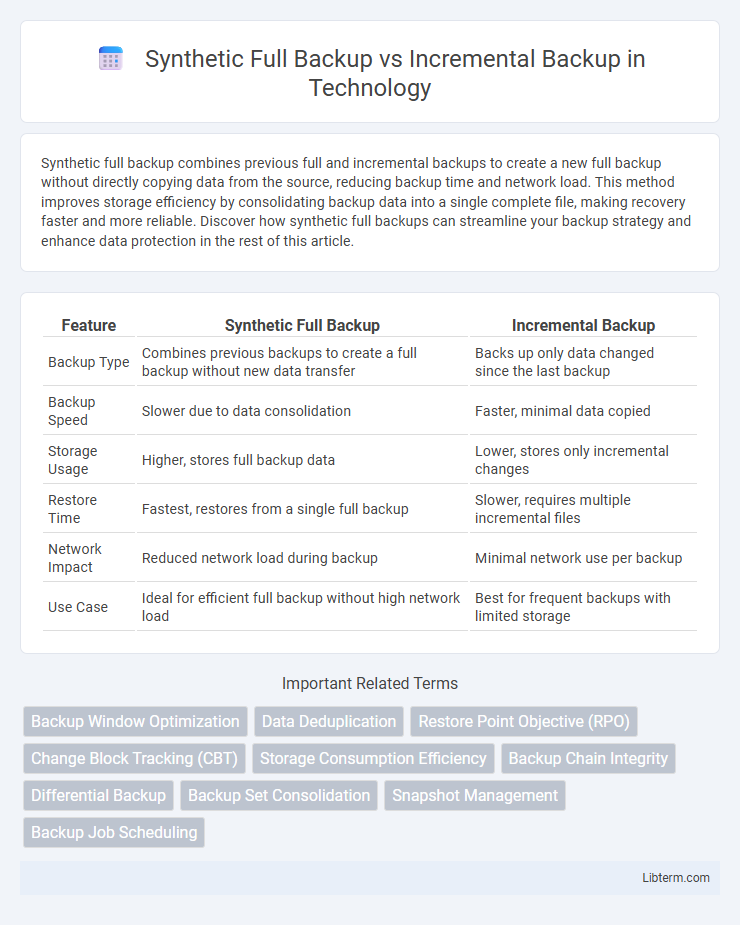Synthetic full backup combines previous full and incremental backups to create a new full backup without directly copying data from the source, reducing backup time and network load. This method improves storage efficiency by consolidating backup data into a single complete file, making recovery faster and more reliable. Discover how synthetic full backups can streamline your backup strategy and enhance data protection in the rest of this article.
Table of Comparison
| Feature | Synthetic Full Backup | Incremental Backup |
|---|---|---|
| Backup Type | Combines previous backups to create a full backup without new data transfer | Backs up only data changed since the last backup |
| Backup Speed | Slower due to data consolidation | Faster, minimal data copied |
| Storage Usage | Higher, stores full backup data | Lower, stores only incremental changes |
| Restore Time | Fastest, restores from a single full backup | Slower, requires multiple incremental files |
| Network Impact | Reduced network load during backup | Minimal network use per backup |
| Use Case | Ideal for efficient full backup without high network load | Best for frequent backups with limited storage |
Understanding Synthetic Full Backup
Synthetic Full Backup consolidates data from previous full and incremental backups to create a complete, up-to-date backup without requiring a new full data copy. This process significantly reduces backup windows and minimizes storage bandwidth usage compared to performing traditional full backups. It optimizes recovery time objectives by maintaining a single, comprehensive backup image that can be restored quickly and efficiently.
What is Incremental Backup?
Incremental backup captures only the data that has changed since the last backup, significantly reducing storage space and backup time compared to full backups. It creates a series of smaller backup sets, requiring all previous increments for a complete restoration. This method optimizes backup routines by minimizing redundant data storage and accelerating backup cycles in data protection strategies.
Key Differences Between Synthetic Full and Incremental Backups
Synthetic full backup merges previous full and incremental backups to create a complete backup without reading all data from the source again, significantly reducing backup time and network load. Incremental backup captures only the changes made since the last backup, optimizing storage space and backup duration but requiring all increments for complete restoration. Key differences include synthetic full backup offering faster recovery times by consolidating data into a single full backup, while incremental backup demands sequential processing of multiple files during restoration.
Advantages of Synthetic Full Backup
Synthetic full backup significantly reduces backup windows by consolidating previous full and incremental backups without repeatedly copying unchanged data. It minimizes storage requirements and network bandwidth usage by reconstructing a current full backup on the backup storage system. This method enhances disaster recovery efficiency with faster restore times compared to traditional full backup approaches.
Benefits of Incremental Backup
Incremental backup significantly reduces storage space and backup time by only capturing changes made since the last backup, enhancing system efficiency. This method decreases network load and speeds up the backup process, allowing for more frequent data protection without taxing resources. Incremental backups also enable faster recovery of recent data compared to traditional full backup methods, minimizing downtime during restoration.
Disadvantages and Limitations of Each Method
Synthetic full backup requires significant computational resources and storage space to combine previous backups into a single file, leading to longer processing times and increased complexity in backup management. Incremental backup relies heavily on the chain of previous backups, making recovery slower and more vulnerable to data corruption if any incremental file is missing or damaged. Both methods face challenges in balancing recovery speed, storage efficiency, and data integrity, with synthetic backups being resource-intensive and incremental backups posing risks in recovery completeness.
Performance and Storage Impact
Synthetic full backup improves performance by consolidating incremental backups into a single full backup without reading all data from the source, reducing network load and backup windows. Incremental backups optimize storage by capturing only changed data since the last backup, significantly lowering storage requirements but potentially increasing restore time due to dependency chains. Balancing synthetic full and incremental backups helps optimize both backup speed and storage efficiency in data protection strategies.
Suitability for Different Backup Strategies
Synthetic full backups create a complete backup by merging previous full and incremental backups, optimizing storage efficiency and reducing backup windows, making them suitable for organizations with limited backup windows and storage resources. Incremental backups only capture changes since the last backup, minimizing backup time and storage but requiring longer restoration times, ideal for environments prioritizing fast backup processes and storage conservation. Selecting between synthetic full and incremental backups depends on recovery time objectives (RTO), storage capacity, and backup window constraints in different IT infrastructures.
Security Considerations for Each Approach
Synthetic full backups consolidate incremental backups into a complete backup without repeatedly transferring all data, reducing exposure to network-based threats by minimizing data in transit. Incremental backups capture only changes since the last backup, requiring rigorous encryption and secure storage to protect multiple dependent backup sets from corruption or ransomware attacks. Both methods necessitate strong access controls and regular verification to ensure data integrity and prevent unauthorized restoration or data breaches.
Choosing the Right Backup Solution for Your Needs
Synthetic full backup consolidates a full backup using previous full and incremental data, reducing the time and network resources needed compared to traditional full backups. Incremental backup saves only the data changed since the last backup, optimizing storage space and backup speed but requiring all increments for complete restoration. Choosing the right backup solution depends on balancing faster recovery times with storage efficiency, considering factors like data change rate, backup window constraints, and disaster recovery priorities.
Synthetic Full Backup Infographic

 libterm.com
libterm.com